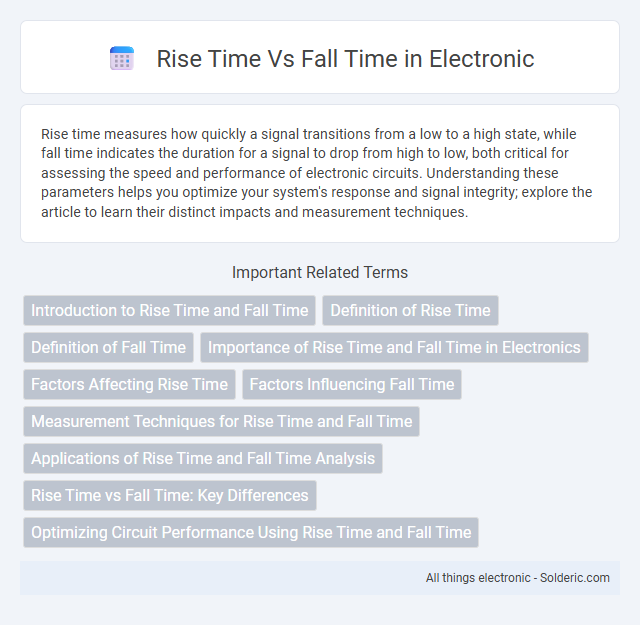Rise time measures how quickly a signal transitions from a low to a high state, while fall time indicates the duration for a signal to drop from high to low, both critical for assessing the speed and performance of electronic circuits. Understanding these parameters helps you optimize your system's response and signal integrity; explore the article to learn their distinct impacts and measurement techniques.
Comparison Table
| Aspect | Rise Time | Fall Time |
|---|---|---|
| Definition | Time taken for a signal to transition from low to high (e.g., 10% to 90% amplitude) | Time taken for a signal to transition from high to low (e.g., 90% to 10% amplitude) |
| Measurement Interval | Low to high voltage level transition | High to low voltage level transition |
| Typical Use | Characterizing speed of signal rising edges in digital and analog circuits | Characterizing speed of signal falling edges in digital and analog circuits |
| Importance | Impacts switching speed and timing accuracy | Impacts switching speed and timing accuracy |
| Influencing Factors | Capacitance, driving strength, device physics | Capacitance, driving strength, device physics |
| Units | Seconds (typically nanoseconds or picoseconds) | Seconds (typically nanoseconds or picoseconds) |
Introduction to Rise Time and Fall Time
Rise time measures the duration required for a signal to transition from a low to a high state, typically from 10% to 90% of its final value, while fall time quantifies the time taken for the signal to drop from high to low, usually from 90% to 10%. These parameters are critical in evaluating the performance of electronic devices, affecting signal integrity and timing accuracy in digital circuits. Precise control of rise and fall times influences switching speed, power consumption, and electromagnetic interference in high-frequency applications.
Definition of Rise Time
Rise time is the duration it takes for a signal to transition from a low value, typically 10%, to a high value, typically 90%, of its final amplitude. It is a critical parameter in electronics and signal processing for measuring how quickly a system responds to changes in input. Understanding your device's rise time helps in optimizing performance and ensuring signal integrity in high-speed applications.
Definition of Fall Time
Fall time is defined as the duration required for a signal to transition from a specified high voltage level, often 90% of its maximum value, down to a specified low voltage level, typically 10%. This parameter is crucial in evaluating the speed at which electronic circuits can switch off or decrease their output. Understanding fall time alongside rise time helps you optimize the performance and response of digital and analog systems.
Importance of Rise Time and Fall Time in Electronics
Rise time and fall time are critical parameters in electronics that determine the speed and performance of digital circuits, influencing signal integrity and timing accuracy. Precise control of rise and fall times minimizes signal distortion, reduces electromagnetic interference (EMI), and enhances overall device reliability. Engineers optimize these times to improve switching speeds in transistors, logic gates, and communication systems, ensuring efficient data transmission and processing in high-frequency applications.
Factors Affecting Rise Time
Rise time is influenced by factors such as the bandwidth of the measurement system, the capacitance of the circuit components, and the intrinsic properties of the signal source. Higher bandwidth reduces rise time by allowing faster signal transitions, while increased capacitance tends to slow down the response, extending the rise time. Signal impedance and the quality of interconnections also impact rise time by introducing delays and distortion in the signal waveform.
Factors Influencing Fall Time
Fall time is influenced by factors such as load capacitance, driver strength, and circuit topology, which determine how quickly the voltage decreases from a high to low state. Larger load capacitance slows the discharge process, increasing fall time, while stronger driver current reduces it by swiftly pulling the signal to ground. Your circuit's material properties and temperature can also impact fall time by affecting resistance and charge mobility.
Measurement Techniques for Rise Time and Fall Time
Precise measurement techniques for rise time and fall time involve using high-bandwidth oscilloscopes with fast edge detection capabilities to accurately capture signal transitions. Time-domain reflectometry and sampling oscilloscopes are commonly employed to analyze rapid changes in voltage levels, ensuring minimal signal distortion during measurement. You can enhance accuracy by using probe compensation and bandwidth-limited filtering to reduce noise and capture the true transition times.
Applications of Rise Time and Fall Time Analysis
Rise time and fall time analysis is critical in high-speed digital communication systems to ensure signal integrity and minimize timing errors. In pulse shaping and switching circuit design, precise measurement of rise and fall times helps optimize performance and reduce electromagnetic interference. These metrics are also essential in LED drivers and audio amplifiers to control transient responses and improve overall device reliability.
Rise Time vs Fall Time: Key Differences
Rise time measures the duration a signal takes to transition from a low to a high voltage threshold, typically from 10% to 90% of its amplitude, while fall time measures the transition from high to low voltage levels within the same percentage range. Key differences include the direction of voltage change and their impact on circuit performance, where faster rise times improve signal responsiveness and faster fall times ensure quick signal deactivation. Accurate measurement of both rise and fall times is essential for optimizing digital circuit speed and minimizing signal distortion.
Optimizing Circuit Performance Using Rise Time and Fall Time
Optimizing circuit performance requires precise control of rise time and fall time, as these parameters directly impact signal integrity and overall speed. Minimizing rise time reduces delay in signal transitions, while controlling fall time prevents signal overshoot and ringing, enhancing stability. You can improve your circuit's efficiency by carefully balancing these timing characteristics to match the specific requirements of your application.
Rise time vs fall time Infographic

 solderic.com
solderic.com